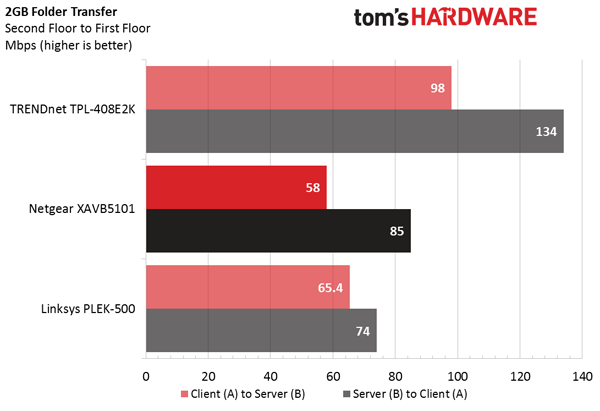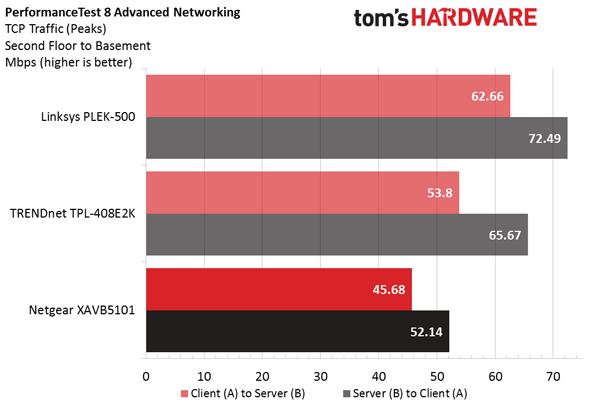Netgear XAV5101 Powerline Networking Adapter Review
Today, we're looking at the Netgear XAV5101 Powerline Adapter, an earlier entry in the AV500 device class, to see how it fares against some of the newer powerline models.
Why you can trust Tom's Hardware
Test Results And Conclusion
Comparison Powerline Networking Adapters
Solo Round
We tested the Netgear XAVB5101 using system configurations and procedures outlined in our How We Test Powerline Adapters article. Here's how the Netgear XAVB5101 performs:
Oddly, the XAV5101 fared better when it was farther apart on the same floor, rather than in the same room, during our 2GB folder transfer. Even in PerformanceTest 8's Advanced Networking Test, our run in the same room barely edged out the measurement from the same floor when looking at peaks only.
However, once you compare the peaks to the averages, we see more performance consistency from the same-room benchmark.
In The Mix
While our initial powerline adapter round-up compared adapters according to the HomePlug specification, marketing trends make it confusing for end-users since the trend seems to be categorizing adapters according to rounded numbers that reflect theoretical performance. Accordingly, we're re-aligning our powerline adapter comparisons according to marketed speeds. Netgear's XAV5101 consequently does battle against two other AV500 powerline adapters, the Trendnet TPL-408E2K and Linksys PLEK500.
We begin with the 2GB folder transferred in the same room:
Netgear underperforms both Linksys and TRENDnet in our Same Room test. Previously, the XAVB5101 actually performed better in the Same Floor test on its own. But will that earn it a higher spot against the other AV500 adapters?
In the Same Floor test, Netgear outmaneuvers Linksys for second place. Let's increase the distance by changing floors.
Get Tom's Hardware's best news and in-depth reviews, straight to your inbox.
The Netgear XAVB5101 maintains second place! Interestingly, TRENDnet's TPL-408E2K really preferred the second floor to its first floor position, even against the Same Floor test, while the numbers for both Netgear and Linksys' PLEK-500 fell a bit.
That performance degradation appears to continue in the next test, from the first floor to the basement.
Netgear is outpaced in the First Floor to Basement test, slipping back into third place.
In the last 2GB folder test from the second floor to the basement, the client/server speeds swapped dominance, with Netgear's XAVB5101 still performing worse than its peers.
We next switch from the native 2GB folder copy test to a purpose-built bandwidth testing software suite from PassMark called PerformanceTest8, re-running the tests from each position. Our first benchmark evaluates the Netgear XAVB5101 kit in the same room using PerformanceTest8 and comparing performance against its AV500 powerline peers.
As in the 2GB folder test, we see Netgear's XAVB5101 perform better on the same floor, moving it into second place.
In the second floor to first floor test, however, Netgear drops into third place as its performance numbers are almost halved.
Thankfully, performance kicks back up a bit in testing from the first floor to the basement.
In the last test from the second floor to the basement, Netgear continues trailing its AV500 peers.
Even though our testing is presented in peak values, the averages don't change this story for Netgear. As we saw from Linksys when we tested UDP throughput, Netgear's XAVB5101 adapters flood the switch, causing extreme packet loss to the extent that testing wasn't possible.
Conclusion
We reached out to Netgear for more information about the performance differences and were advised that, at this point in the product's life cycle, its XAVB5101 is outdated compared to more recent offerings. Netgear was an early contender in pursuing a powerline product that supported the HomePlug AV specification, though. As such, the companion chipset chosen to go with Atheros' AR8035-A, the Atheros AR1500-AL1C, is older than the companion chipset used in competing adapters. This could have been a key factor in the XAVB5101's lower performance numbers. More evidence supporting that theory is that Atheros' AR1540, the companion chipset used in higher-performing powerline adapters we've reviewed, was Qualcomm's first chipset marketed as HomePlug AV2-compliant, and it's capable of achieving higher speeds.
Amazon and Newegg list the Netgear XAVB5101 for around $70 although you may find it for less at Netgear with a Netgear promo code. For the same price, you can get Linksys' PLEK-500, which is more consistent in its higher performance. The Netgear loyal might not mind this kit's shortcomings, but I would recommend a different solution based on our results, especially if you're performance-obsessed.
MORE: Powerline Networking 101
MORE: How We Test Powerline Adapters
MORE: All Powerline Content
MORE: All Networking Content
Matthew Matchen is an Associate Contributing Writer for Tom's Hardware. Follow him on Twitter @matchemm.
Follow us on Twitter @tomshardware, on Facebook and on Google+.
-
Gigahertz20 Powerline networking is too inconsistent, I bought a bunch to network a friends house and they were terrible for speeds so they got returned. We bought a couple MoCA adapters and networked his house using the existing coax cable outlets, works great. I wish MoCA would have caught on more, they are a little expensive but totally work it. Just search for MoCA 2.0 on Amazon, you can get two bonded MoCA 2.0 adapters for around $190. The 2.0 version is suppose to be very fast.Reply -
rantoc Doing only bandwidth measurements don't paint the entire picture, latency is in many cases are even more important than the pure bandwidth (when speaking about faster connections)Reply -
malhussaini re:rmse17Reply
Latency in my experience for powerline networks is 3-4 ms compared to less than 1 ms for ethernet. -
az_fred I bought a pair of Netgear AV500 powerline adapters about a year ago. To my surprise they are working out wonderfully. One unit actually has built in WiFi to cover a dead spot in my house. I can consistently get over 30 Mbps over WiFi which is great for browsing and movies on my tablet. It works nearly all the time, with an occasional reset. The pair only cost about $70 at my local Fry's. It was much better than I thought it was going to be!Reply -
InvalidError Same room, floor or whatever else is of little importance. What matters is wiring distance and tidiness between the two adapters.Reply
If both adapters are on the same breaker run (often but not always the case within a given room) and there are no dirty loads putting noise on it or EMI filters attenuating the signal, you get good performance. If the two adapters are on different breakers on the same phase at the breaker box, you get lower performance due to additional attenuation and wiring in-between. If the other adapter is on the other phase, you get worse attenuation still since only the signal traveling on the neutral reaches the other branches and further reduced performance. -
truerock Is Matthew Matchen mentally unstable. How could he write an entire article about Powerline and not explain how home electrical wiring is done. Somehow he thinks that the distance between 2 electrical outlets is somehow relevant. Is Matchen completely braindead?Reply -
dragget We've now had two successive Powerline reviews. Both kits reviewed have been based on HomePlug equipment that is 3-4 years from the current state of the art. I have a set of HomePlug AV2 adapters that I've been using for 4 years now which are based on the same chipset as the units in the review. Personally, I'd prefer information on how the new MIMO stuff stacks up. Wouldn't it be more helpful to most of your readers to test and review newer products?Reply -
truerock The AV2-MIMO adapters typically run around 100Mbps in a worst case scenario (e.g. long run through a circuit breaker). The newer G.hn adapters (e.g. using Marvel chipsets) increase that to about 140Mbps.Reply
I have no idea why anyone would waste their time testing obsolete Home AV adapters. -
truerock http://www.homeplug.org/explore-homeplug/faq-consumers/#AV2aReply
I’ve read about AV2 for a while, how is AV2 MIMO better than existing HomePlug AV and AV2 products?
The short answer is improved quality of service (QOS) and coverage to all areas of the home. The existing HomePlug AV and AV2 products use 2 wires (hot and neutral) and can be referred to as “SISO” (for single-input / single output). AV2 MIMO with beam forming uses those 2 wires plus the ground to greatly increase the reliability of high-bandwidth service to all areas of the home by a factor 2 to 4 times as compared to earlier technology (MIMO stands for multiple-in / multiple out).














